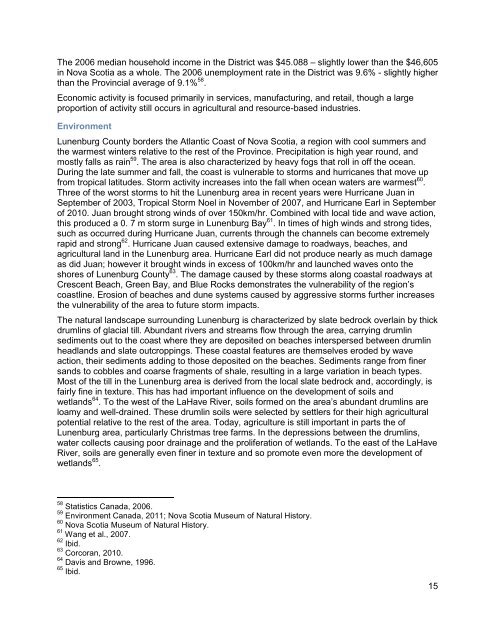Lunenburg Part 1 - Introduction and Background August 30.pdf
Lunenburg Part 1 - Introduction and Background August 30.pdf
Lunenburg Part 1 - Introduction and Background August 30.pdf
Create successful ePaper yourself
Turn your PDF publications into a flip-book with our unique Google optimized e-Paper software.
The 2006 median household income in the District was $45.088 – slightly lower than the $46,605<br />
in Nova Scotia as a whole. The 2006 unemployment rate in the District was 9.6% - slightly higher<br />
than the Provincial average of 9.1% 58 .<br />
Economic activity is focused primarily in services, manufacturing, <strong>and</strong> retail, though a large<br />
proportion of activity still occurs in agricultural <strong>and</strong> resource-based industries.<br />
Environment<br />
<strong>Lunenburg</strong> County borders the Atlantic Coast of Nova Scotia, a region with cool summers <strong>and</strong><br />
the warmest winters relative to the rest of the Province. Precipitation is high year round, <strong>and</strong><br />
mostly falls as rain 59 . The area is also characterized by heavy fogs that roll in off the ocean.<br />
During the late summer <strong>and</strong> fall, the coast is vulnerable to storms <strong>and</strong> hurricanes that move up<br />
from tropical latitudes. Storm activity increases into the fall when ocean waters are warmest 60 .<br />
Three of the worst storms to hit the <strong>Lunenburg</strong> area in recent years were Hurricane Juan in<br />
September of 2003, Tropical Storm Noel in November of 2007, <strong>and</strong> Hurricane Earl in September<br />
of 2010. Juan brought strong winds of over 150km/hr. Combined with local tide <strong>and</strong> wave action,<br />
this produced a 0. 7 m storm surge in <strong>Lunenburg</strong> Bay 61 . In times of high winds <strong>and</strong> strong tides,<br />
such as occurred during Hurricane Juan, currents through the channels can become extremely<br />
rapid <strong>and</strong> strong 62 . Hurricane Juan caused extensive damage to roadways, beaches, <strong>and</strong><br />
agricultural l<strong>and</strong> in the <strong>Lunenburg</strong> area. Hurricane Earl did not produce nearly as much damage<br />
as did Juan; however it brought winds in excess of 100km/hr <strong>and</strong> launched waves onto the<br />
shores of <strong>Lunenburg</strong> County 63 . The damage caused by these storms along coastal roadways at<br />
Crescent Beach, Green Bay, <strong>and</strong> Blue Rocks demonstrates the vulnerability of the region’s<br />
coastline. Erosion of beaches <strong>and</strong> dune systems caused by aggressive storms further increases<br />
the vulnerability of the area to future storm impacts.<br />
The natural l<strong>and</strong>scape surrounding <strong>Lunenburg</strong> is characterized by slate bedrock overlain by thick<br />
drumlins of glacial till. Abundant rivers <strong>and</strong> streams flow through the area, carrying drumlin<br />
sediments out to the coast where they are deposited on beaches interspersed between drumlin<br />
headl<strong>and</strong>s <strong>and</strong> slate outcroppings. These coastal features are themselves eroded by wave<br />
action, their sediments adding to those deposited on the beaches. Sediments range from finer<br />
s<strong>and</strong>s to cobbles <strong>and</strong> coarse fragments of shale, resulting in a large variation in beach types.<br />
Most of the till in the <strong>Lunenburg</strong> area is derived from the local slate bedrock <strong>and</strong>, accordingly, is<br />
fairly fine in texture. This has had important influence on the development of soils <strong>and</strong><br />
wetl<strong>and</strong>s 64 . To the west of the LaHave River, soils formed on the area’s abundant drumlins are<br />
loamy <strong>and</strong> well-drained. These drumlin soils were selected by settlers for their high agricultural<br />
potential relative to the rest of the area. Today, agriculture is still important in parts the of<br />
<strong>Lunenburg</strong> area, particularly Christmas tree farms. In the depressions between the drumlins,<br />
water collects causing poor drainage <strong>and</strong> the proliferation of wetl<strong>and</strong>s. To the east of the LaHave<br />
River, soils are generally even finer in texture <strong>and</strong> so promote even more the development of<br />
wetl<strong>and</strong>s 65 .<br />
58 Statistics Canada, 2006.<br />
59 Environment Canada, 2011; Nova Scotia Museum of Natural History.<br />
60 Nova Scotia Museum of Natural History.<br />
61 Wang et al., 2007.<br />
62 Ibid.<br />
63 Corcoran, 2010.<br />
64 Davis <strong>and</strong> Browne, 1996.<br />
65 Ibid.<br />
15














